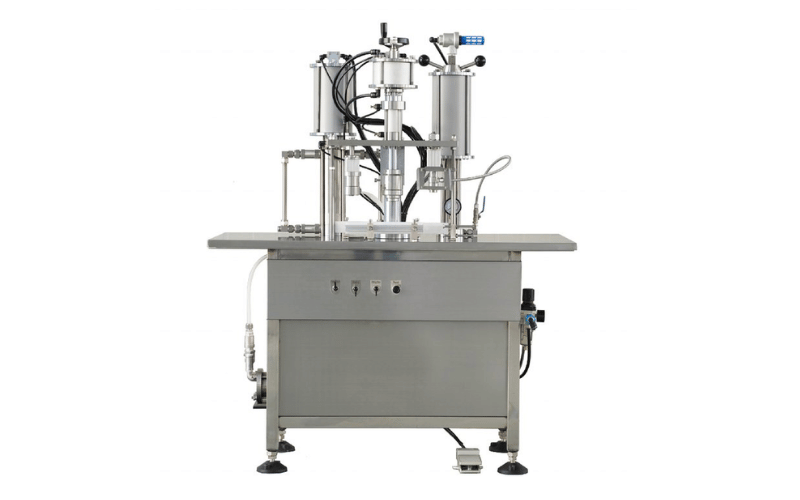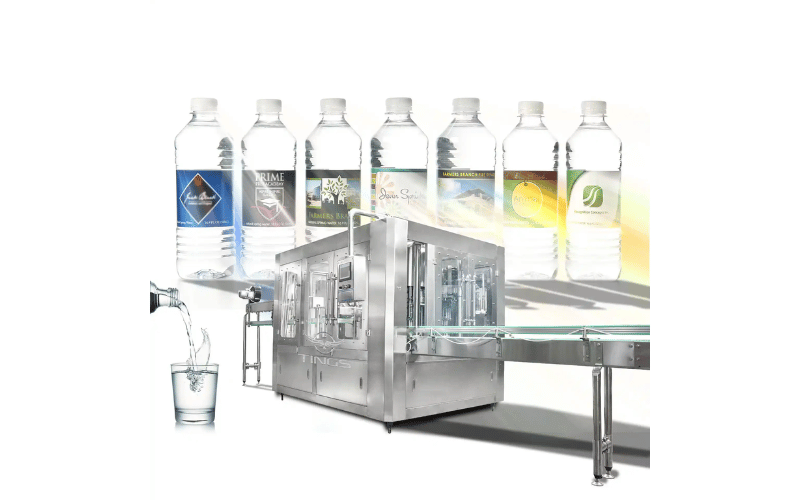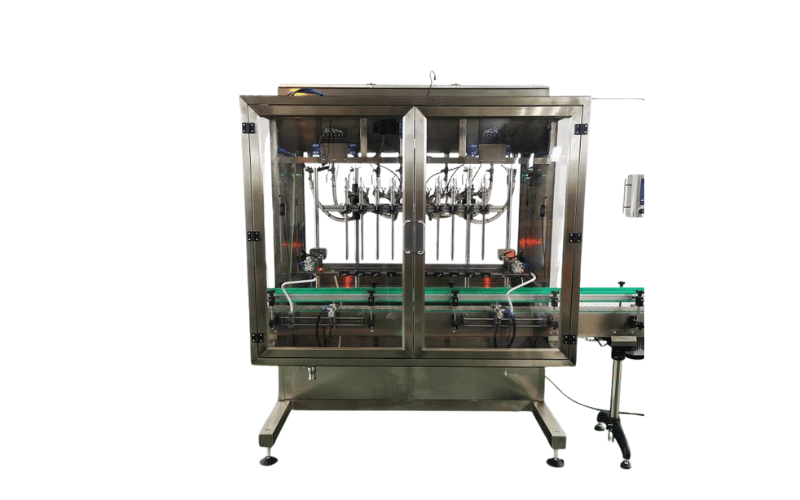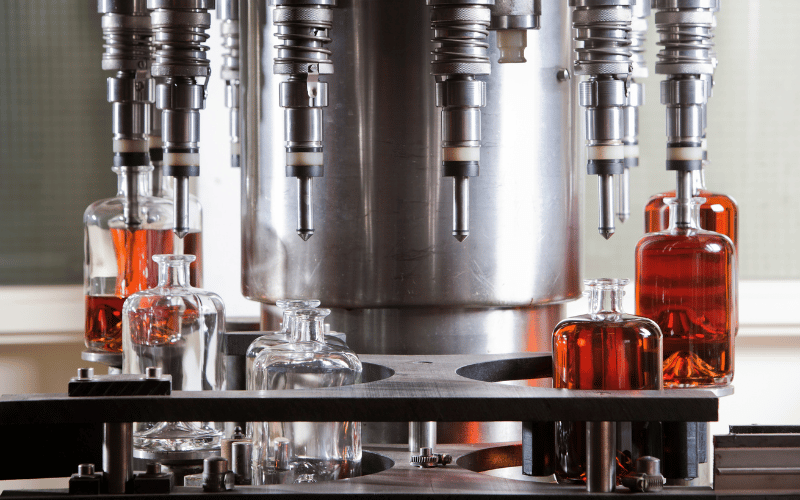Efficient liquid filling is a cornerstone of the beverage industry, ensuring that products are packaged with precision, quality, and speed. Wine bottle filling machines and bottling lines have evolved to meet the diverse needs of wineries, breweries, and beverage manufacturers, offering solutions tailored to different production scales and beverage types. From gravity fillers for still wines to counter-pressure systems for sparkling beverages, these machines play a critical role in maintaining product integrity and meeting consumer expectations. This guide explores the various types of filling equipment, their features, and the latest innovations shaping the future of liquid filling technology.
Table of Contents
ToggleUnderstanding Wine Bottle Fillers
Types of Wine Bottle Fillers
Wine bottle fillers come in various types, each designed to meet specific production needs and ensure the quality of the wine during the bottling process.
- Gravity Fillers: These machines rely on gravity to fill bottles, making them ideal for still wines. They are simple to operate and cost-effective, making them a popular choice for small wineries.
- Vacuum Fillers: Vacuum systems draw wine into the bottle by creating a vacuum, reducing oxygen exposure, and preserving the wine’s flavor and aroma. These fillers are perfect for high-quality or premium wines.
- Counter Pressure Fillers: Designed for sparkling wines, these machines maintain equal pressure inside the bottle and the storage tank during the filling process. This prevents foaming and ensures the wine retains its carbonation.
- Manual Fillers: Manual fillers are suitable for small-scale operations or home winemakers. They require full operator involvement but offer precise control over the filling process.
- Automatic Fillers: Automatic systems are ideal for medium to large-scale wineries. They handle multiple steps, including filling, capping, and sometimes labeling, which significantly increases efficiency and reduces labor.
How a Wine Bottle Filling Machine Works
A wine bottle filling machine operates by transferring wine from storage tanks into bottles while maintaining the wine’s quality and minimizing waste.
- Bottle Preparation: Bottles are cleaned and sanitized to remove any contaminants. This step ensures the wine remains safe and fresh.
- Filling Process: The machine fills the bottles using gravity, vacuum, or counter pressure, depending on the type of filler. This step is carefully controlled to prevent spillage and maintain consistent fill levels.
- Oxygen Management: Many machines include features like nitrogen purging to remove oxygen from the bottle before filling. This helps preserve the wine’s flavor and extends its shelf life.
- Capping or Corking: After filling, the bottles are sealed with corks, screw caps, or other closures to protect the wine from oxidation and contamination.
Key Features of a Bottle Filler
When selecting a wine bottle filler, it’s important to consider the key features that enhance efficiency and maintain product quality.
- Adjustable Fill Levels: Machines with adjustable settings allow wineries to handle different bottle sizes and ensure consistent fill levels.
- Oxygen Control: Features like nitrogen purging or vacuum filling reduce oxygen exposure, preserving the wine’s taste and aroma.
- Speed and Capacity: High-speed machines are essential for large-scale operations, while smaller systems are better suited for boutique wineries.
- Ease of Cleaning: Machines with self-cleaning or easy-to-disassemble parts simplify maintenance and reduce downtime.
- Compatibility: Ensure the filler is compatible with your bottle types, whether they are glass, plastic, or unique shapes.
- Automation Options: Automatic fillers with integrated capping and labeling systems streamline the bottling process, saving time and labor.
By understanding these features and how wine bottle fillers work, wineries can choose the right equipment to meet their production goals and maintain the quality of their wine.
Automatic Filling Machines in the Beverage Industry
Benefits of Automatic Bottle Filling
Automatic bottle filling machines offer numerous advantages that make them indispensable in the beverage industry.
- Increased Efficiency: These machines significantly speed up the bottling process, allowing manufacturers to meet high production demands without compromising quality.
- Consistency and Precision: Automatic systems ensure uniform fill levels in every bottle, reducing waste and maintaining product quality.
- Labor Savings: By automating repetitive tasks like filling and capping, these machines reduce the need for manual labor, freeing up staff for other critical operations.
- Reduced Contamination Risk: Automated systems minimize human contact with the product, ensuring better hygiene and compliance with food safety standards.
- Versatility: Many automatic fillers can handle various container sizes and beverage types, making them suitable for a wide range of applications.
Types of Automatic Filling Equipment
Automatic filling machines come in different types, each designed to meet specific production needs and beverage characteristics.
- Gravity Fillers: These machines rely on gravity to fill containers, making them ideal for non-carbonated beverages like water, juice, and wine. They are simple to operate and cost-effective for medium-scale production.
- Vacuum Fillers: Vacuum systems draw liquid into the container by creating a vacuum, reducing oxygen exposure and preserving the product’s quality. These are commonly used for high-end beverages like wine and spirits.
- Counter Pressure Fillers: Designed for carbonated drinks, these machines maintain equal pressure inside the container and the storage tank during filling. This prevents foaming and ensures the beverage retains its carbonation.
- Rotary Fillers: High-speed rotary systems are perfect for large-scale operations. They can fill multiple containers simultaneously, significantly increasing production capacity.
- Piston Fillers: These machines use a piston to measure and dispense precise amounts of liquid, making them ideal for thicker beverages like syrups or smoothies.
Comparing Gravity vs. Vacuum Bottle Fillers
Gravity and vacuum bottle fillers are two popular options in the beverage industry, each with its own strengths and applications.
- Gravity Fillers:
- Best For: Non-carbonated beverages like water, juice, and still wine.
- Advantages: Simple design, cost-effective, and easy to maintain.
- Limitations: Not suitable for carbonated drinks or beverages that require oxygen control.
- Vacuum Fillers:
- Best For: High-quality beverages like wine, spirits, and oils.
- Advantages: Reduces oxygen exposure, preserving flavor and extending shelf life.
- Limitations: Higher initial cost and slower than gravity fillers for large-scale production.
Choosing between gravity and vacuum fillers depends on the type of beverage, production scale, and quality requirements. Gravity fillers are ideal for cost-conscious operations, while vacuum fillers are better suited for premium products that demand superior quality control.
Filling and Packaging Process
Steps in the Bottle Filling Process
The bottle filling process involves several key steps to ensure beverages are packaged efficiently and maintain their quality.
- Bottle Preparation: Bottles are cleaned and sanitized to remove any contaminants. This step is crucial for ensuring product safety and extending shelf life.
- Pre-Filling Purge: Many systems use nitrogen or CO2 to purge oxygen from the bottles before filling. This minimizes oxidation, which can degrade the flavor and freshness of the beverage.
- Filling: The liquid is dispensed into the bottles using gravity, vacuum, or counter pressure systems, depending on the beverage type. This step ensures consistent fill levels and minimizes spillage.
- Capping or Sealing: After filling, bottles are immediately sealed with caps, corks, or other closures to preserve the product’s quality and prevent contamination.
- Inspection and Labeling: Filled bottles are inspected for quality, ensuring proper fill levels and secure seals. They are then labeled and prepared for distribution.
Importance of Accurate Liquid Filling
Accurate liquid filling is essential for maintaining product quality, reducing waste, and ensuring customer satisfaction.
- Consistency: Precise filling ensures that every bottle contains the correct amount of liquid, meeting customer expectations and regulatory requirements.
- Cost Efficiency: Avoiding overfilling reduces product waste, while underfilling prevents customer complaints and potential legal issues.
- Preservation of Quality: Accurate filling minimizes oxygen exposure, preserving the flavor, carbonation, and shelf life of the beverage.
- Brand Reputation: Consistently filled bottles reflect a professional and reliable brand image, building trust with consumers.
Investing in high-quality filling equipment with advanced features like automated adjustments and real-time monitoring can help achieve accurate and efficient liquid filling.
Packaging Solutions for Different Beverages
Different beverages require tailored packaging solutions to meet their unique characteristics and market demands.
- Carbonated Beverages: These drinks, such as soda and sparkling water, require counter pressure filling systems to maintain carbonation and prevent foaming. Aluminum cans and PET bottles are common packaging options due to their durability and lightweight nature.
- Still Beverages: Non-carbonated drinks like juice, water, and tea can be packaged using gravity or vacuum fillers. Glass bottles and cartons are popular choices for premium products, while plastic bottles are widely used for affordability and convenience.
- Alcoholic Beverages: Wine, beer, and spirits often require specialized packaging to preserve their quality. Counter pressure fillers are ideal for carbonated beers, while vacuum fillers are preferred for wine and spirits to reduce oxygen exposure. Glass bottles are the standard for these beverages, offering a premium look and feel.
- Dairy and Plant-Based Drinks: Milk, yogurt, and plant-based alternatives like almond or oat milk need aseptic packaging to ensure freshness and safety. Cartons and plastic bottles with tamper-evident seals are commonly used.
- Specialty Beverages: Functional drinks, energy drinks, and smoothies often require unique packaging to stand out. Sleek cans, custom-shaped bottles, and vibrant labeling help attract consumer attention.
By selecting the right packaging solution for each beverage type, manufacturers can enhance product appeal, ensure quality, and meet consumer expectations.
Specialized Fillers for Different Liquids
Wine vs. Beer Bottle Filling Machines
Wine and beer bottle filling machines are designed to meet the unique requirements of each beverage, ensuring quality and efficiency during the bottling process.
- Wine Bottle Filling Machines: These machines often use vacuum or gravity filling systems to minimize oxygen exposure, preserving the wine’s flavor and aroma. They are ideal for still wines and can handle various bottle sizes, including premium glass bottles. Some models also include nitrogen purging to further protect the wine’s quality.
- Beer Bottle Filling Machines: Beer fillers typically use counter pressure systems to maintain carbonation and prevent foaming during the filling process. These machines are designed to handle both glass bottles and cans, making them versatile for breweries of all sizes. Advanced models often include integrated capping systems to seal the bottles immediately after filling.
The choice between these machines depends on the beverage type, with wine fillers focusing on oxygen control and beer fillers prioritizing carbonation retention.
Filling Equipment for Spirits and Cider
Spirits and cider require specialized filling equipment to address their unique characteristics and packaging needs.
- Spirits: Filling machines for spirits like whiskey, vodka, and gin often use vacuum systems to ensure precise fill levels and reduce spillage. These machines are compatible with glass bottles, which are the standard for premium spirits. Many models also include features like tamper-evident sealing and labeling for added security and branding.
- Cider: Cider fillers are similar to beer filling machines, especially for carbonated ciders. Counter pressure systems are used to maintain carbonation and prevent foaming. For still ciders, gravity or vacuum fillers are more suitable. These machines can handle a variety of packaging options, including glass bottles and cans.
By using the right equipment, manufacturers can ensure that spirits and cider are packaged efficiently while maintaining their quality and appeal.
Handling Carbonated Beverages
Carbonated beverages require specialized filling systems to preserve their carbonation and prevent excessive foaming during the bottling process.
- Counter Pressure Filling: This method maintains equal pressure inside the container and the storage tank, ensuring the beverage retains its carbonation. It is widely used for soda, sparkling water, beer, and carbonated ciders.
- Foam Control: Advanced machines include features like pre-evacuation and CO2 purging to minimize foaming, ensuring consistent fill levels and reducing product loss.
- Sealing and Capping: Carbonated beverages must be sealed immediately after filling to lock in carbonation. Many machines integrate capping systems to streamline this process.
- Temperature Management: Filling carbonated beverages at lower temperatures helps reduce foaming and ensures a smoother filling process.
By investing in high-quality filling equipment designed for carbonated drinks, manufacturers can deliver consistent, high-quality products to their customers.
Materials and Construction of Filling Machines
Food Grade Materials in Bottle Fillers
Bottle filling machines use food-grade materials to ensure safety, hygiene, and compliance with industry standards. These materials prevent contamination and maintain the quality of the beverages during the filling process.
- Stainless Steel: Most filling machines are constructed with stainless steel, which is non-reactive, easy to clean, and resistant to corrosion. This makes it ideal for handling beverages like wine, beer, and carbonated drinks.
- Food-Grade Plastics: Components like gaskets, seals, and tubing often use food-grade plastics that are durable and safe for contact with liquids. These materials are designed to withstand high temperatures and repeated use.
- Silicone and EPDM: These materials are commonly used for seals and O-rings in filling machines. They provide excellent resistance to chemicals and wear, ensuring a tight seal and preventing leaks.
Using food-grade materials ensures that filling machines meet regulatory requirements and deliver safe, high-quality products to consumers.
Advantages of 304 Stainless Steel in Equipment
304 stainless steel is the most commonly used material in filling machines due to its numerous advantages.
- Corrosion Resistance: 304 stainless steel resists rust and corrosion, even when exposed to acidic beverages like wine or citrus-based drinks. This extends the machine’s lifespan and reduces maintenance costs.
- Hygiene: The smooth surface of 304 stainless steel prevents bacteria and residue from accumulating, making it easy to clean and sanitize. This is essential for maintaining food safety standards.
- Durability: This material is highly durable and can withstand the wear and tear of daily operations, including exposure to high temperatures and pressure.
- Aesthetic Appeal: 304 stainless steel has a polished, professional appearance, which enhances the overall look of the equipment.
- Recyclability: As an eco-friendly material, 304 stainless steel is fully recyclable, aligning with sustainability goals in the beverage industry.
These benefits make 304 stainless steel the preferred choice for manufacturers looking to build reliable and long-lasting filling machines.
Durability and Maintenance of Filling Machines
Durability and proper maintenance are critical for ensuring the long-term performance of filling machines.
- Robust Construction: High-quality materials like stainless steel and food-grade plastics enhance the durability of filling machines, allowing them to withstand heavy use in demanding production environments.
- Regular Cleaning: Cleaning the machine after each production cycle prevents residue buildup and ensures hygiene. Many machines include self-cleaning features to simplify this process.
- Routine Inspections: Regularly inspecting components like seals, valves, and gaskets helps identify wear and tear early, preventing costly breakdowns.
- Lubrication: Keeping moving parts well-lubricated reduces friction and extends the lifespan of the machine. Use food-safe lubricants to maintain compliance with safety standards.
- Replacement of Worn Parts: Replacing worn or damaged parts promptly ensures the machine continues to operate efficiently and minimizes downtime.
By following a consistent maintenance schedule and using durable materials, manufacturers can maximize the efficiency and lifespan of their filling machines.
Future Trends in Filling Technology
Innovations in Liquid Filling Solutions
The liquid filling industry is evolving rapidly, with new technologies enhancing efficiency, precision, and product quality.
- Smart Sensors and IoT Integration: Modern filling machines now include sensors and Internet of Things (IoT) technology to monitor fill levels, pressure, and temperature in real time. This ensures consistent quality and reduces waste by detecting issues early.
- High-Speed Filling Systems: Advanced systems are designed to handle higher production volumes without compromising accuracy. These machines are ideal for large-scale operations looking to scale efficiently.
- Customizable Equipment: Manufacturers are offering more flexible machines that can adapt to different container sizes, liquid viscosities, and production requirements. This versatility is especially valuable for businesses producing a variety of products.
- Improved Foam Control: For carbonated beverages, new counter pressure systems and vacuum technology are reducing foam during filling, ensuring consistent fill levels and minimizing product loss.
Automating the Bottling Line: What to Expect
Automation is transforming bottling lines, making them faster, smarter, and more efficient.
- Fully Integrated Systems: Automated bottling lines now combine multiple processes, including filling, capping, labeling, and quality inspection, into a single streamlined system. This reduces manual intervention and speeds up production.
- AI-Powered Quality Control: Artificial intelligence is being used to detect defects in real time, such as improper fill levels or faulty seals. This ensures only high-quality products reach the market.
- Robotic Arms: Robotic arms are increasingly used for tasks like bottle placement, capping, and packaging. They improve precision and reduce the risk of human error.
- Remote Monitoring: Automation systems now allow operators to monitor and control the bottling line remotely, providing real-time data and alerts for better decision-making.
As automation continues to advance, bottling lines will become more efficient, reducing costs and improving product consistency.
Sustainability in Beverage Packaging
Sustainability is a growing focus in the beverage industry, and filling technology is adapting to meet these demands.
- Eco-Friendly Materials: Filling machines are being optimized for recyclable and biodegradable packaging materials, such as lightweight aluminum cans and plant-based plastics. These options reduce waste and appeal to environmentally conscious consumers.
- Energy-Efficient Systems: Modern filling equipment is designed to consume less energy, lowering the carbon footprint of the bottling process. Many machines now include energy-saving features like variable speed drives.
- Water Conservation: Advanced cleaning and filling systems use less water, addressing one of the industry’s biggest sustainability challenges. Some machines even recycle water used during the cleaning process.
- Carbon Neutral Operations: Breweries and beverage manufacturers are adopting carbon-neutral filling lines by integrating renewable energy sources and offsetting emissions. This aligns with broader industry goals to reduce environmental impact.
By embracing these trends, the beverage industry is not only improving efficiency but also contributing to a more sustainable future.
Frequently Asked Questions
Q: What is a wine filling machine and how does it work?
A: A wine filling machine is specialized equipment designed to efficiently and precisely fill wine bottles during the bottling process. It uses methods like gravity filling or counter pressure filling to control the liquid flow and minimize oxidation. These machines accommodate various bottle sizes and fill volumes, ensuring accurate fills without spillage or waste.
Q: What are the benefits of using an automatic wine bottle filler?
A: An automatic wine bottle filler improves efficiency and consistency in the bottling process. It reduces reliance on manual labor, minimizing human error, and supports higher production rates. These machines can adjust to different fill volumes and often include features like spring-loaded valves and nozzles to ensure precise filling while reducing foam.
Q: How does a counter pressure bottle filler work for wine?
A: A counter pressure bottle filler maintains the wine’s integrity by pressurizing the bottle and the wine before filling. This controlled process prevents foaming and ensures consistent fill levels, making it especially effective for sparkling wines. By maintaining equal pressure, the filler minimizes carbonation loss and preserves the wine’s quality.
Q: What types of pumps are used in wine filling machines?
A: Wine filling machines use pumps like volumetric pumps and diaphragm pumps to handle the wine’s viscosity and ensure accurate flow rates. High-pressure pumps may also be used in systems requiring efficient filling, particularly for thicker liquids or when using vacuum fillers for specific applications.
Q: Can wine filling machines be used for other beverages like juice or beer?
A: Yes, many wine filling machines can adapt to fill other beverages like juice and beer. Adjustable features make them versatile for handling different liquids. However, specialized fillers for juice or beer may include components designed to manage carbonation or viscosity differences more effectively.
Q: What are the key specifications to consider when choosing a wine filling machine?
A: When selecting a wine filling machine, consider its filling speed, the type of filling system (gravity or counter pressure), the number of filling heads (e.g., 4-head models for higher output), and the material used, such as food-grade 304 stainless steel. Also, check if the machine accommodates various bottle sizes and offers features like adjustable fill levels and foam reduction.
Q: How does a conveyor system improve the wine bottling process?
A: A conveyor system streamlines the wine bottling process by moving bottles efficiently between stations, reducing manual handling. This continuous flow speeds up production, minimizes contamination risks, and prevents damage to bottles during handling, making the entire process more efficient.
Q: What role does oxidation play in the wine filling process?
A: Oxidation can negatively impact the wine’s flavor and quality by exposing it to air. To prevent this, wine filling machines use techniques like counter pressure filling or vacuum filling to limit oxygen exposure during bottling. These methods help preserve the wine’s integrity and ensure it reaches consumers in optimal condition.
Concluding Summary
The advancements in wine bottle filling machines and bottling lines have revolutionized the beverage industry, offering unparalleled efficiency, precision, and sustainability. By understanding the unique features of different fillers, such as gravity, vacuum, and counter pressure systems, manufacturers can select the right equipment to meet their production goals. Automation and sustainability are driving the future of filling technology, with innovations like IoT integration, AI-powered quality control, and eco-friendly packaging solutions leading the way. As the industry continues to evolve, these technologies will enable manufacturers to deliver high-quality products while reducing environmental impact and operational costs.





